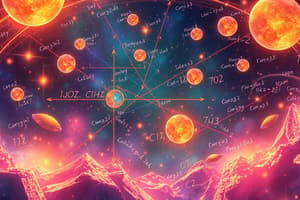Podcast
Questions and Answers
Which number system encompasses both rational and irrational numbers?
Which number system encompasses both rational and irrational numbers?
- Real Numbers (R) (correct)
- Complex Numbers (C)
- Natural Numbers (N)
- Integers (Z)
The study of trigonometry primarily focuses on the relationships between the sides of squares and their respective angles.
The study of trigonometry primarily focuses on the relationships between the sides of squares and their respective angles.
False (B)
What is the result of repeated addition of a number to itself referred to as in mathematics?
What is the result of repeated addition of a number to itself referred to as in mathematics?
Multiplication
In algebra, symbols that represent unknown values are called ______.
In algebra, symbols that represent unknown values are called ______.
Match the following mathematical areas with their descriptions:
Match the following mathematical areas with their descriptions:
Which of the following is an example of an irrational number?
Which of the following is an example of an irrational number?
A line, in geometric terms, is a finite path with two endpoints.
A line, in geometric terms, is a finite path with two endpoints.
In calculus, what concept describes the value that a function approaches as the input gets closer to a specific value?
In calculus, what concept describes the value that a function approaches as the input gets closer to a specific value?
Flashcards
Arithmetic
Arithmetic
The study of numbers and basic operations.
Algebra
Algebra
Mathematical symbols and rules to manipulate them.
Geometry
Geometry
Shapes, sizes, figures positions, and their properties in space.
Calculus
Calculus
Signup and view all the flashcards
Trigonometry
Trigonometry
Signup and view all the flashcards
Natural Numbers (N)
Natural Numbers (N)
Signup and view all the flashcards
Real Numbers (R)
Real Numbers (R)
Signup and view all the flashcards
Variables
Variables
Signup and view all the flashcards
Study Notes
- Mathematics is the abstract study of topics such as quantity, structure, space, and change.
Core Areas of Mathematics
- Arithmetic studies numbers and basic operations like addition, subtraction, multiplication, and division.
- Algebra studies mathematical symbols and the rules for manipulating these symbols.
- Geometry studies shapes, sizes, positions of figures, and properties of space.
- Calculus studies continuous change and includes topics like limits, derivatives, integrals, and functions.
- Trigonometry studies relationships between angles and sides of triangles.
Number Systems
- Natural Numbers (N): Positive integers starting from 1 (1, 2, 3, ...).
- Whole Numbers (W): Natural numbers including 0 (0, 1, 2, 3, ...).
- Integers (Z): Whole numbers and their negatives (... -3, -2, -1, 0, 1, 2, 3, ...).
- Rational Numbers (Q): Numbers that can be expressed as a fraction p/q, where p and q are integers and q ≠ 0 (e.g., 1/2, -3/4, 5).
- Irrational Numbers: Numbers that cannot be expressed as a fraction of two integers, having non-repeating, non-terminating decimal representations (e.g., √2, π).
- Real Numbers (R): Includes both rational and irrational numbers, representing all points on a number line.
- Complex Numbers (C): Numbers in the form a + bi, where a and b are real numbers, and i is the imaginary unit (√-1).
Basic Operations
- Addition: Combining two or more numbers to find their sum.
- Subtraction: Finding the difference between two numbers.
- Multiplication: Repeated addition of a number.
- Division: Splitting a number into equal parts.
- Exponentiation: Raising a number to a power.
- Root Extraction: Finding the root of a number.
Algebra Fundamentals
- Variables: Symbols representing unknown values.
- Expressions: Combinations of variables, numbers, and operations.
- Equations: Statements asserting the equality of two expressions.
- Polynomials: Expressions consisting of variables and coefficients, involving only the operations of addition, subtraction, multiplication, and non-negative integer exponents.
Geometry Concepts
- Points: Exact locations in space.
- Lines: Straight paths extending infinitely in both directions.
- Planes: Flat surfaces extending infinitely in all directions.
- Angles: Formed by two rays sharing a common endpoint (vertex).
- Triangles: Three-sided polygons.
- Quadrilaterals: Four-sided polygons.
- Circles: Set of all points equidistant from a center point.
Calculus Principles
- Limits: The value that a function approaches as the input approaches some value.
- Derivatives: Measure the instantaneous rate of change of a function.
- Integrals: Calculate the area under a curve.
- Functions: Relationships between input and output values.
Trigonometry Basics
- Sine (sin): Ratio of the length of the opposite side to the length of the hypotenuse in a right-angled triangle.
- Cosine (cos): Ratio of the length of the adjacent side to the length of the hypotenuse in a right-angled triangle.
- Tangent (tan): Ratio of the length of the opposite side to the length of the adjacent side in a right-angled triangle.
- Pythagorean Theorem: In a right-angled triangle, a² + b² = c², where a and b are the lengths of the legs and c is the length of the hypotenuse.
Studying That Suits You
Use AI to generate personalized quizzes and flashcards to suit your learning preferences.




